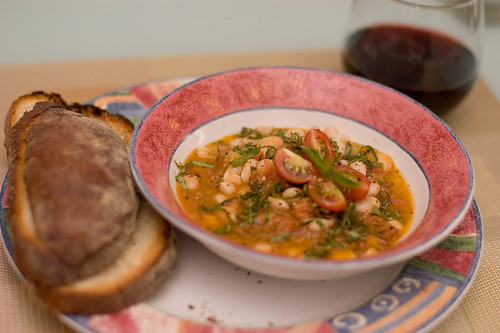In general, I am bad a ranking things, especially in the upper tail of their distributions. This is an exception. It is the essence of summer, made with strictly fresh ingredients at the peak of their seasons, and deeply, deeply satisfying. I submit that there could not possibly be any better midday meal than this tuscan-style bean and tomato stew served with red wine and good crusty bread.
There are a few rules to assert from the outset. First, this dish is to be served with red wine and crusty bread. No spoons, no soggy bread, no white wine, nor any other beverage. Second, I love bean and tomato stew even when it is made in the winter with dried or canned beans and canned tomatoes; however, that is simply bean and tomato stew. This is August stew and will allow no substitutions of these ingredients: fresh beans, fresh heirloom tomatoes, fresh garlic, and fresh herbs. By heirloom tomatoes I mean you either grew them yourself, or you talked to the farmer who did. Choose a variety like these Black Cherokees or even more acidic Green Zebras. Yellow tomatoes are generally low in acid, and I think a bad choice for this dish. Some of the marbley looking yellow-red ones are beautiful on the plate or in a salad, and should be saved for those uses. The herbs can be anything you have or grow or find. I've focused on basil today, but rosemary and thyme and sage and parsley are all good. I especially like sage in the winter version of the dish. Late August is also when the first juicy heads of mature garlic are coming to market. Common rubbery grocery-store stuff is not appropriate for this dish. Good crusty bread comes from an artisan bakery or your oven, ferments and rises for many hours, and contains no fat, only yeast, flour, water, and salt.
For two lunch servings, I used about half to three-quarters of a pound of beans, a pound of tomato (two large ones), four cloves of fresh garlic, chopped as large or as small as you like, and a quarter cup of olive oil. The quantities are flexible; if you like garlic, by all means add more.
 Start by heating olive oil gently in a heavy pot; chop the garlic and add it. An enameled cast-iron pot heats slowly but retains heat well. I start with a cold pan over medium heat and that seems to work perfectly for the quantities and timings discussed here.
Start by heating olive oil gently in a heavy pot; chop the garlic and add it. An enameled cast-iron pot heats slowly but retains heat well. I start with a cold pan over medium heat and that seems to work perfectly for the quantities and timings discussed here.
 While it continues to heat, large-dice the tomatoes.
While it continues to heat, large-dice the tomatoes.
 When the garlic is barely golden at the edges – that is, the same color at which you would add the shrimp in gambas al ajillo – add the tomatoes.
When the garlic is barely golden at the edges – that is, the same color at which you would add the shrimp in gambas al ajillo – add the tomatoes.
Shell the beans, and by the time you’re done, 

the tomatoes will have broken down.
 Add the beans, adjust the heat as you see fit, cover or don't cover, stir, and then walk away. I took a shower, because I started right after having gone running. Twenty minutes or so later, the beans will be soft, and it's time to add some salt and pepper and any of the tougher herbs like sage or rosemary, stir, and stew ten minutes more.
Add the beans, adjust the heat as you see fit, cover or don't cover, stir, and then walk away. I took a shower, because I started right after having gone running. Twenty minutes or so later, the beans will be soft, and it's time to add some salt and pepper and any of the tougher herbs like sage or rosemary, stir, and stew ten minutes more.
 Finally, I added some basil cut in chiffonade (without any finger this year), though most of the basil I reserved to top the finished stew with. Finish with a sliced cherry tomato or diced fresh tomato, more basil, a drizzle of good olive oil, and some salt and pepper.
Finally, I added some basil cut in chiffonade (without any finger this year), though most of the basil I reserved to top the finished stew with. Finish with a sliced cherry tomato or diced fresh tomato, more basil, a drizzle of good olive oil, and some salt and pepper.

Eat. I like to start with the crustiest part of the bread. Any crumbs fall in, making it thicker; at the end, use the soft inside bread to mop up the bowl. If you run out of bread, get more. Do not use a spoon.
1 comment:
The wine, btw, got a separate post.
Post a Comment